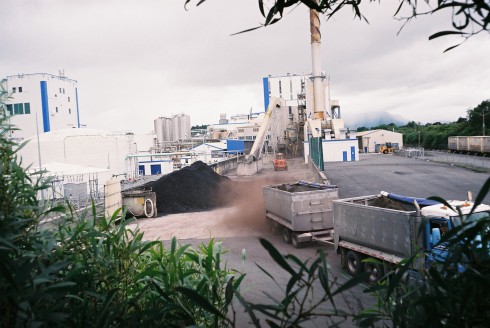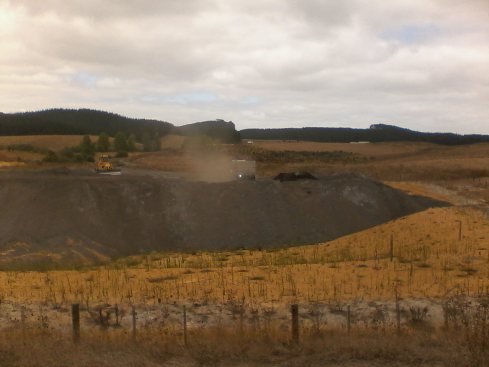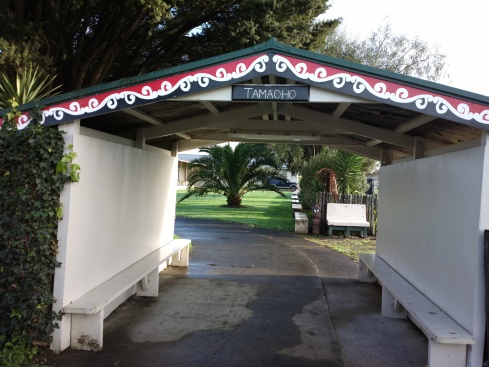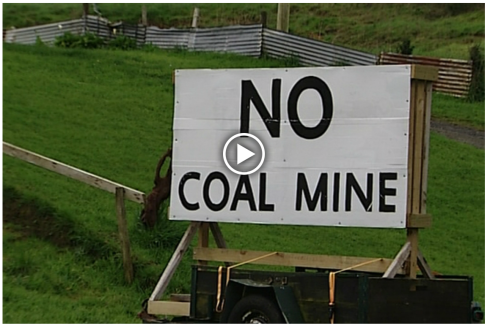When Auckland Coal Action’s Geoff Mason found out about the proposed new coal mine at Mangatangi, he set off by bus and bicycle to investigate Fonterra’s mining and coal burning operations. He found that Fonterra and its mining subsidiary Glencoal were not meeting their own environmental standards and, in some cases were even breaching the conditions of their resource consents.
At the Mangatangi Mine hearings last week, he reported his findings to commissioners.
Glencoal is applying for resource consent to open a new coal mine at Mangatawhiri in the north Waikato (called the Mangatangi Mine). The mine is intended to replace the expiring Kopako 3 mine and will supply coal to Fonterra dairy factories for use in their boilers.
Coal burning dangerous for the climate, is it also dangerous for coal mining communities?
Those of us at Auckland Coal Action are keenly aware of the dangerous impacts that burning coal is already having on the climate and are determined that no new coal mines should be opened. As Geoaff stated in his submission:
Because the coal is there under the ground it is a waste to not mine it, is the train of thought. The consequence of extending this logic is that in a hundred years’ time the landscape of this area will be dotted with craters where there once was farmland. If extended globally we will have a near 4 degree Celsius temperature rise by 2100.
However, is it also harmful for the local communities living around the Waikato’s coal mines and coal-burning factories? Geoff reasoned that a look at Fonterra and Glencoal’s current practices should give us some idea of what to expect from a new mine, and what he found was far from encouraging.
Fonterra is not following its own standards
Can we trust Fonterra and its subsidiary, Glencoal? Auckland Coal Action’s observations have led us to believe we can’t.
Coal ash is a product of burning coal in Fonterra’s factories. It is returned to Kopako 3 mine for disposal.
Fonterra has said that it transports this coal ash from its factories using covered trucks.
It has also said that sprinklers above the coal delivery area at Waitoa Dairy Factory are used to wet down the coal dust when necessary.
However, this photo taken in December of last year shows an uncovered coal ash truck leaving the Waitoa factory, kicking up coal dust from the coal bunker to the left.
Disposal of coal ash at Kopako 3
Glencoal would have us believe that the following are standard practices used at their sites to control dust and coal ash:
- Covering trucks when transporting coal ash
- Watering coal ash piles to avoid the ash becoming airborne
On visits Geoff made to Kopako 3 he was able to observe breaches to these standards.
4 March 2013
Geoff observed an uncovered coal ash truck arriving at the coal ash dump. It kicked up coal ash dust due to lack of consistent watering of the ash pile.
11 March 2013
Geoff had reported his observations to local Mangatawhiri residents at a public meeting on the 7th. When he visited the mine on the 11th, it seemed that Glencoal became aware they were being watched and attempted to prevent dust from being kicked up by an ash truck that was due to arrive later in the day.
Geoff notes:
On March the 11th after the meeting I observed two covered ash trucks arrive. I also observed this coal ash dust cloud being kicked up from the coal ash dump after a watering truck attempted to catch up on neglected watering.
Below is a sequence of photos of the dust cloud that occurred over two minutes.
Why should we believe that Glencoal will water around their coal piles at the Mangatangi mine or cover their trucks as they say they will? Are the residents of Mangatawhiri and Mangatangi going to have to be constantly checking up on Glencoal to get them to follow the consent conditions for this mine?
Breaching resource consent conditions
One of the consent conditions at the existing Kopako 3 mine is to ensure that particulate emissions are not visible in the air beyond the boundary of the site. [Reference: Introduction to Section 2 of the assessment of environmental effects of discharges to air of the K3 mine]
On 4 March after the uncovered truck had gone, Geoff noted that:
The wind was picking the ash up off the dump and blowing it way up in the air. It would have been blowing horizontally for miles. The wind on that day was blowing the dust roughly in the direction of the houses on Kopuku Rd.
On 23 March, Geoff further observed a dump truck in the backfill area kicking up a dust cloud twice the height of the one in this video. Footage was taken at the Kopako 3 restoration area.
If dust emissions do exceed allowable limits, the company is required to submit an incident report to the Waikato Regional Council within five days. Geoff was able to find no such report in Council files.
Glencoal conveniently omits boron exceedance at hearing
During Glencoal submissions in favour of the Mangatangi Mine, they consistently emphasised their standards for strict environmental controls of dust. Geoff is not confident that these will be followed. His research has also led him to be concerned for the quality of water being discharged from the mine.
He notes:
The evidence on water treatment given in the first week of the hearing stated that based on a review of the water treatment plant operational records, treated water consistently meets the required discharge standard for turbidity. What was conveniently omitted was that Council records show that in April this year the levels of boron in the discharge from the K3 water treatment plant reached 10.8g/m3, exceeding the 10.00g/m3 limit. As a result of this Glencoal were inquiring about applying to irrigate their farmland with the polluted boron rich waste water next summer.
Geoff has since found that another expert had the cheek to include a graph of boron levels between 2005 and 2012, but omitted 2013 readings.
Consent conditions were watered down
Even where a resource consent is able to impose strict conditions, there is nothing to stop a company from later applying to have the conditions weakened. As Geoff stated:
From Fonterra and Glencoal’s past record, we don’t trust that Glencoal at a later date will not apply to the council to have consent conditions relaxed. I have found three occasions where Fonterra or Glencoal have successfully applied or submitted to have air quality regulations relaxed.
Recent examples where Fonterra or Glencoal have succeeded in getting conditions relaxed:
- Only a few years ago, Fonterra made a submission to the government to increase the permitted number of exceedances of the PM10 standard, from one to three exceedances per year, and also to extend the timeline for compliance to 2018. (What is PM10?)
- In 2009, Fonterra successfully applied to the council for an increase in the particulate emission limit for the coal-fired boiler at Te Awamutu from 50 mg/m3 to 100 mg/m3, due to difficulty complying with the 50 mg/m3 limit. The health of the people of Te Awamutu was compromised so that Fonterra wouldn’t have to upgrade its dust removal.
- In 2007 Glencoal successfully applied to the council to reduce the level of reporting on air quality and to remove conditions requiring quantitative monitoring by way of despositional dust gauges at K3.
We strongly oppose this resource consent!
Auckland Coal Action strongly opposes resource consent being granted for the Mangatangi Mine at Mangatawhiri.
Our main concern is that most of the known coal reserves must stay in the ground to avoid triggering runaway climate change. However, Geoff’s observations have shown that coal mining and burning is far from safe for the neighbouring communities of such operations.
Even if strict conditions are laid out for the control of dust for this mine, locals can have little faith that conditions will be followed. There is also no guarantee that conditions will not be later relaxed.
This mine should not go ahead.























